Boris Bonev
A Library for Learning Neural Operators
Dec 13, 2024
Abstract:We present NeuralOperator, an open-source Python library for operator learning. Neural operators generalize neural networks to maps between function spaces instead of finite-dimensional Euclidean spaces. They can be trained and inferenced on input and output functions given at various discretizations, satisfying a discretization convergence properties. Built on top of PyTorch, NeuralOperator provides all the tools for training and deploying neural operator models, as well as developing new ones, in a high-quality, tested, open-source package. It combines cutting-edge models and customizability with a gentle learning curve and simple user interface for newcomers.
Data-driven Surface Solar Irradiance Estimation using Neural Operators at Global Scale
Nov 13, 2024



Abstract:Accurate surface solar irradiance (SSI) forecasting is essential for optimizing renewable energy systems, particularly in the context of long-term energy planning on a global scale. This paper presents a pioneering approach to solar radiation forecasting that leverages recent advancements in numerical weather prediction (NWP) and data-driven machine learning weather models. These advances facilitate long, stable rollouts and enable large ensemble forecasts, enhancing the reliability of predictions. Our flexible model utilizes variables forecast by these NWP and AI weather models to estimate 6-hourly SSI at global scale. Developed using NVIDIA Modulus, our model represents the first adaptive global framework capable of providing long-term SSI forecasts. Furthermore, it can be fine-tuned using satellite data, which significantly enhances its performance in the fine-tuned regions, while maintaining accuracy elsewhere. The improved accuracy of these forecasts has substantial implications for the integration of solar energy into power grids, enabling more efficient energy management and contributing to the global transition to renewable energy sources.
Modulated Adaptive Fourier Neural Operators for Temporal Interpolation of Weather Forecasts
Oct 24, 2024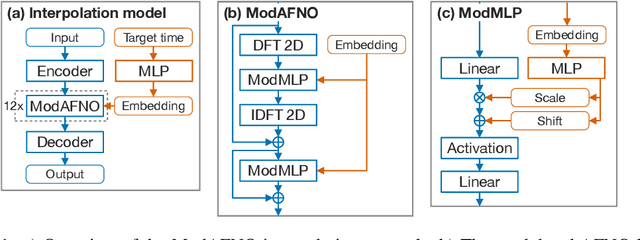
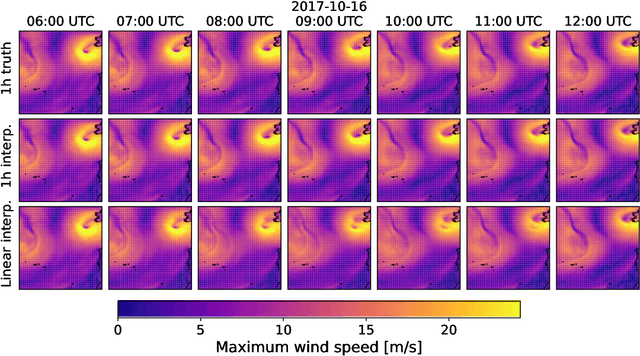
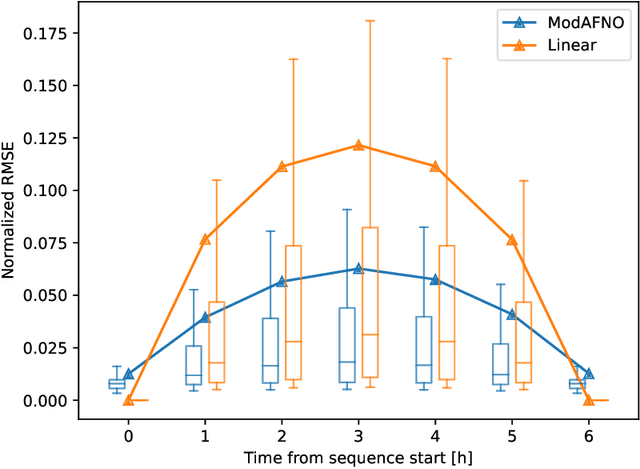
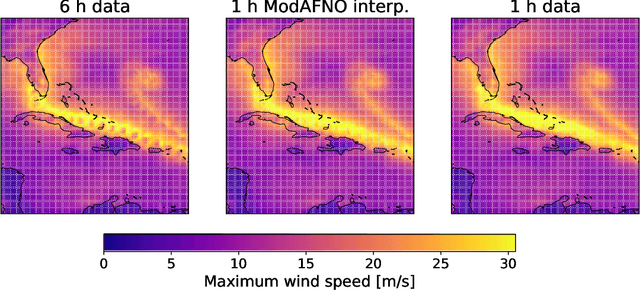
Abstract:Weather and climate data are often available at limited temporal resolution, either due to storage limitations, or in the case of weather forecast models based on deep learning, their inherently long time steps. The coarse temporal resolution makes it difficult to capture rapidly evolving weather events. To address this limitation, we introduce an interpolation model that reconstructs the atmospheric state between two points in time for which the state is known. The model makes use of a novel network layer that modifies the adaptive Fourier neural operator (AFNO), which has been previously used in weather prediction and other applications of machine learning to physics problems. The modulated AFNO (ModAFNO) layer takes an embedding, here computed from the interpolation target time, as an additional input and applies a learned shift-scale operation inside the AFNO layers to adapt them to the target time. Thus, one model can be used to produce all intermediate time steps. Trained to interpolate between two time steps 6 h apart, the ModAFNO-based interpolation model produces 1 h resolution intermediate time steps that are visually nearly indistinguishable from the actual corresponding 1 h resolution data. The model reduces the RMSE loss of reconstructing the intermediate steps by approximately 50% compared to linear interpolation. We also demonstrate its ability to reproduce the statistics of extreme weather events such as hurricanes and heat waves better than 6 h resolution data. The ModAFNO layer is generic and is expected to be applicable to other problems, including weather forecasting with tunable lead time.
Exploring the design space of deep-learning-based weather forecasting systems
Oct 09, 2024
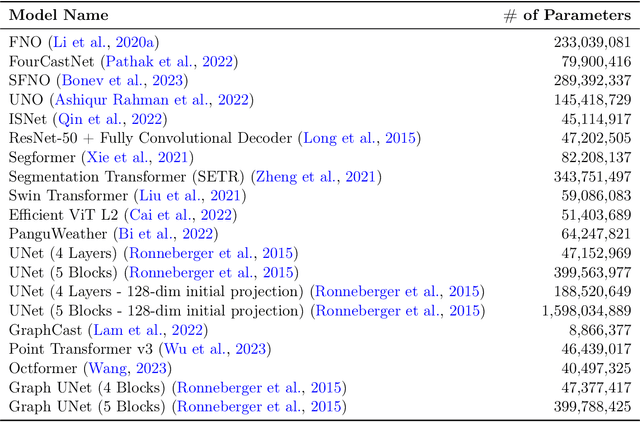

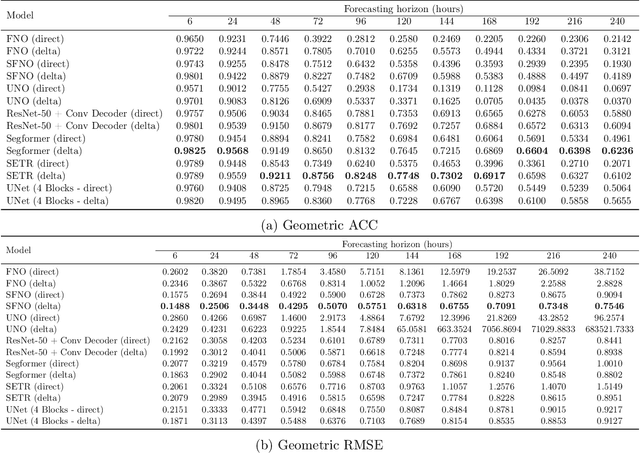
Abstract:Despite tremendous progress in developing deep-learning-based weather forecasting systems, their design space, including the impact of different design choices, is yet to be well understood. This paper aims to fill this knowledge gap by systematically analyzing these choices including architecture, problem formulation, pretraining scheme, use of image-based pretrained models, loss functions, noise injection, multi-step inputs, additional static masks, multi-step finetuning (including larger stride models), as well as training on a larger dataset. We study fixed-grid architectures such as UNet, fully convolutional architectures, and transformer-based models, along with grid-invariant architectures, including graph-based and operator-based models. Our results show that fixed-grid architectures outperform grid-invariant architectures, indicating a need for further architectural developments in grid-invariant models such as neural operators. We therefore propose a hybrid system that combines the strong performance of fixed-grid models with the flexibility of grid-invariant architectures. We further show that multi-step fine-tuning is essential for most deep-learning models to work well in practice, which has been a common practice in the past. Pretraining objectives degrade performance in comparison to supervised training, while image-based pretrained models provide useful inductive biases in some cases in comparison to training the model from scratch. Interestingly, we see a strong positive effect of using a larger dataset when training a smaller model as compared to training on a smaller dataset for longer. Larger models, on the other hand, primarily benefit from just an increase in the computational budget. We believe that these results will aid in the design of better weather forecasting systems in the future.
Huge Ensembles Part I: Design of Ensemble Weather Forecasts using Spherical Fourier Neural Operators
Aug 06, 2024



Abstract:Studying low-likelihood high-impact extreme weather events in a warming world is a significant and challenging task for current ensemble forecasting systems. While these systems presently use up to 100 members, larger ensembles could enrich the sampling of internal variability. They may capture the long tails associated with climate hazards better than traditional ensemble sizes. Due to computational constraints, it is infeasible to generate huge ensembles (comprised of 1,000-10,000 members) with traditional, physics-based numerical models. In this two-part paper, we replace traditional numerical simulations with machine learning (ML) to generate hindcasts of huge ensembles. In Part I, we construct an ensemble weather forecasting system based on Spherical Fourier Neural Operators (SFNO), and we discuss important design decisions for constructing such an ensemble. The ensemble represents model uncertainty through perturbed-parameter techniques, and it represents initial condition uncertainty through bred vectors, which sample the fastest growing modes of the forecast. Using the European Centre for Medium-Range Weather Forecasts Integrated Forecasting System (IFS) as a baseline, we develop an evaluation pipeline composed of mean, spectral, and extreme diagnostics. Using large-scale, distributed SFNOs with 1.1 billion learned parameters, we achieve calibrated probabilistic forecasts. As the trajectories of the individual members diverge, the ML ensemble mean spectra degrade with lead time, consistent with physical expectations. However, the individual ensemble members' spectra stay constant with lead time. Therefore, these members simulate realistic weather states, and the ML ensemble thus passes a crucial spectral test in the literature. The IFS and ML ensembles have similar Extreme Forecast Indices, and we show that the ML extreme weather forecasts are reliable and discriminating.
Huge Ensembles Part II: Properties of a Huge Ensemble of Hindcasts Generated with Spherical Fourier Neural Operators
Aug 02, 2024



Abstract:In Part I, we created an ensemble based on Spherical Fourier Neural Operators. As initial condition perturbations, we used bred vectors, and as model perturbations, we used multiple checkpoints trained independently from scratch. Based on diagnostics that assess the ensemble's physical fidelity, our ensemble has comparable performance to operational weather forecasting systems. However, it requires several orders of magnitude fewer computational resources. Here in Part II, we generate a huge ensemble (HENS), with 7,424 members initialized each day of summer 2023. We enumerate the technical requirements for running huge ensembles at this scale. HENS precisely samples the tails of the forecast distribution and presents a detailed sampling of internal variability. For extreme climate statistics, HENS samples events 4$\sigma$ away from the ensemble mean. At each grid cell, HENS improves the skill of the most accurate ensemble member and enhances coverage of possible future trajectories. As a weather forecasting model, HENS issues extreme weather forecasts with better uncertainty quantification. It also reduces the probability of outlier events, in which the verification value lies outside the ensemble forecast distribution.
Coupled Ocean-Atmosphere Dynamics in a Machine Learning Earth System Model
Jun 12, 2024



Abstract:Seasonal climate forecasts are socioeconomically important for managing the impacts of extreme weather events and for planning in sectors like agriculture and energy. Climate predictability on seasonal timescales is tied to boundary effects of the ocean on the atmosphere and coupled interactions in the ocean-atmosphere system. We present the Ocean-linked-atmosphere (Ola) model, a high-resolution (0.25{\deg}) Artificial Intelligence/ Machine Learning (AI/ML) coupled earth-system model which separately models the ocean and atmosphere dynamics using an autoregressive Spherical Fourier Neural Operator architecture, with a view towards enabling fast, accurate, large ensemble forecasts on the seasonal timescale. We find that Ola exhibits learned characteristics of ocean-atmosphere coupled dynamics including tropical oceanic waves with appropriate phase speeds, and an internally generated El Ni\~no/Southern Oscillation (ENSO) having realistic amplitude, geographic structure, and vertical structure within the ocean mixed layer. We present initial evidence of skill in forecasting the ENSO which compares favorably to the SPEAR model of the Geophysical Fluid Dynamics Laboratory.
Pretraining Codomain Attention Neural Operators for Solving Multiphysics PDEs
Mar 19, 2024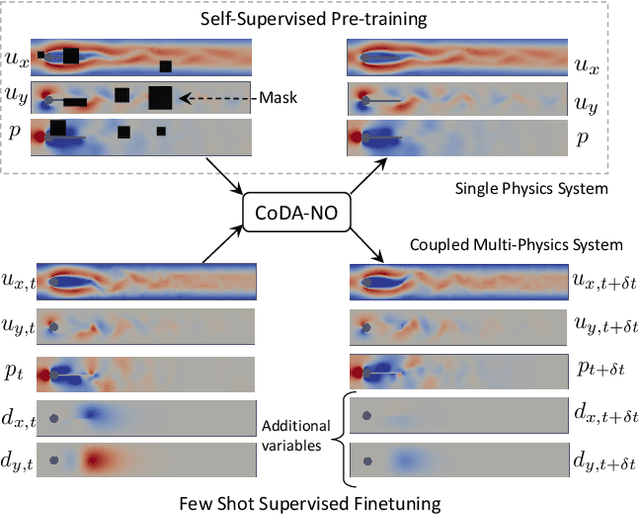


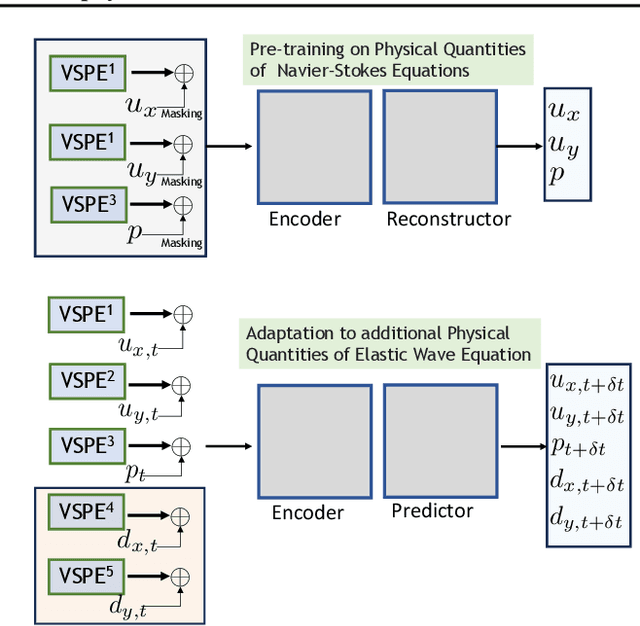
Abstract:Existing neural operator architectures face challenges when solving multiphysics problems with coupled partial differential equations (PDEs), due to complex geometries, interactions between physical variables, and the lack of large amounts of high-resolution training data. To address these issues, we propose Codomain Attention Neural Operator (CoDA-NO), which tokenizes functions along the codomain or channel space, enabling self-supervised learning or pretraining of multiple PDE systems. Specifically, we extend positional encoding, self-attention, and normalization layers to the function space. CoDA-NO can learn representations of different PDE systems with a single model. We evaluate CoDA-NO's potential as a backbone for learning multiphysics PDEs over multiple systems by considering few-shot learning settings. On complex downstream tasks with limited data, such as fluid flow simulations and fluid-structure interactions, we found CoDA-NO to outperform existing methods on the few-shot learning task by over $36\%$. The code is available at https://github.com/ashiq24/CoDA-NO.
Neural Operators with Localized Integral and Differential Kernels
Feb 26, 2024Abstract:Neural operators learn mappings between function spaces, which is practical for learning solution operators of PDEs and other scientific modeling applications. Among them, the Fourier neural operator (FNO) is a popular architecture that performs global convolutions in the Fourier space. However, such global operations are often prone to over-smoothing and may fail to capture local details. In contrast, convolutional neural networks (CNN) can capture local features but are limited to training and inference at a single resolution. In this work, we present a principled approach to operator learning that can capture local features under two frameworks by learning differential operators and integral operators with locally supported kernels. Specifically, inspired by stencil methods, we prove that we obtain differential operators under an appropriate scaling of the kernel values of CNNs. To obtain local integral operators, we utilize suitable basis representations for the kernels based on discrete-continuous convolutions. Both these approaches preserve the properties of operator learning and, hence, the ability to predict at any resolution. Adding our layers to FNOs significantly improves their performance, reducing the relative L2-error by 34-72% in our experiments on turbulent 2D Navier-Stokes fluid flow and the spherical shallow water equations.
A Practical Probabilistic Benchmark for AI Weather Models
Jan 27, 2024Abstract:Since the weather is chaotic, forecasts aim to predict the distribution of future states rather than make a single prediction. Recently, multiple data driven weather models have emerged claiming breakthroughs in skill. However, these have mostly been benchmarked using deterministic skill scores, and little is known about their probabilistic skill. Unfortunately, it is hard to fairly compare AI weather models in a probabilistic sense, since variations in choice of ensemble initialization, definition of state, and noise injection methodology become confounding. Moreover, even obtaining ensemble forecast baselines is a substantial engineering challenge given the data volumes involved. We sidestep both problems by applying a decades-old idea -- lagged ensembles -- whereby an ensemble can be constructed from a moderately-sized library of deterministic forecasts. This allows the first parameter-free intercomparison of leading AI weather models' probabilistic skill against an operational baseline. The results reveal that two leading AI weather models, i.e. GraphCast and Pangu, are tied on the probabilistic CRPS metric even though the former outperforms the latter in deterministic scoring. We also reveal how multiple time-step loss functions, which many data-driven weather models have employed, are counter-productive: they improve deterministic metrics at the cost of increased dissipation, deteriorating probabilistic skill. This is confirmed through ablations applied to a spherical Fourier Neural Operator (SFNO) approach to AI weather forecasting. Separate SFNO ablations modulating effective resolution reveal it has a useful effect on ensemble dispersion relevant to achieving good ensemble calibration. We hope these and forthcoming insights from lagged ensembles can help guide the development of AI weather forecasts and have thus shared the diagnostic code.
 Add to Chrome
Add to Chrome Add to Firefox
Add to Firefox Add to Edge
Add to Edge